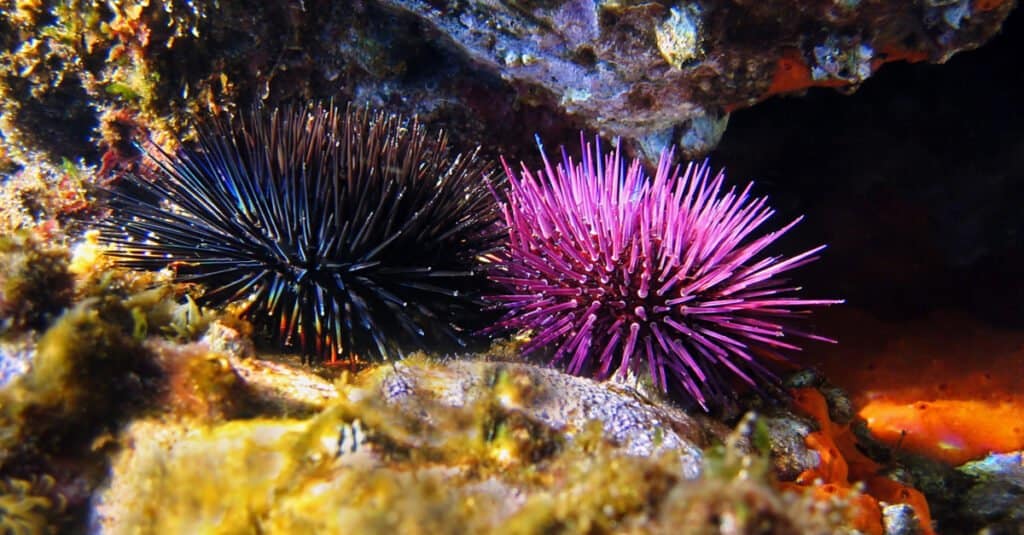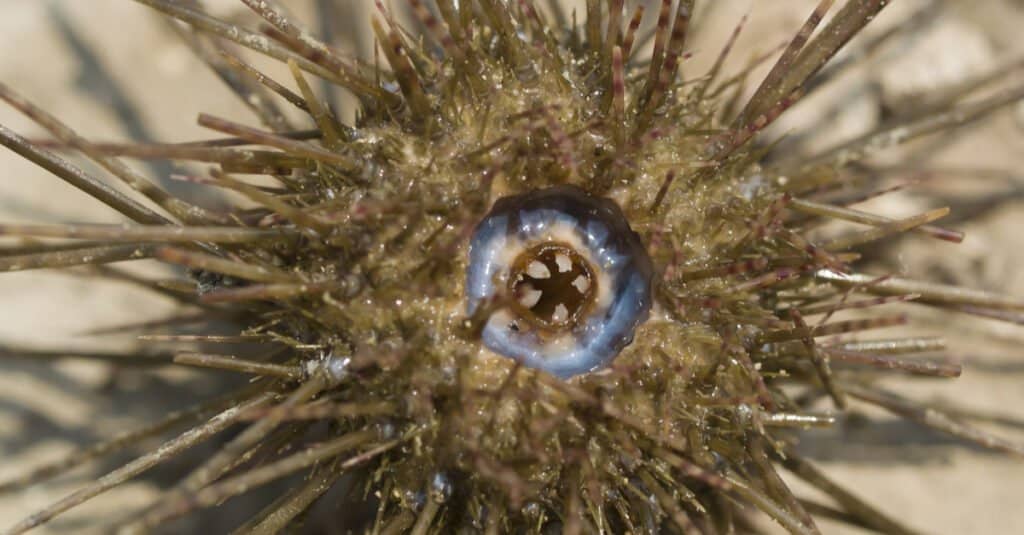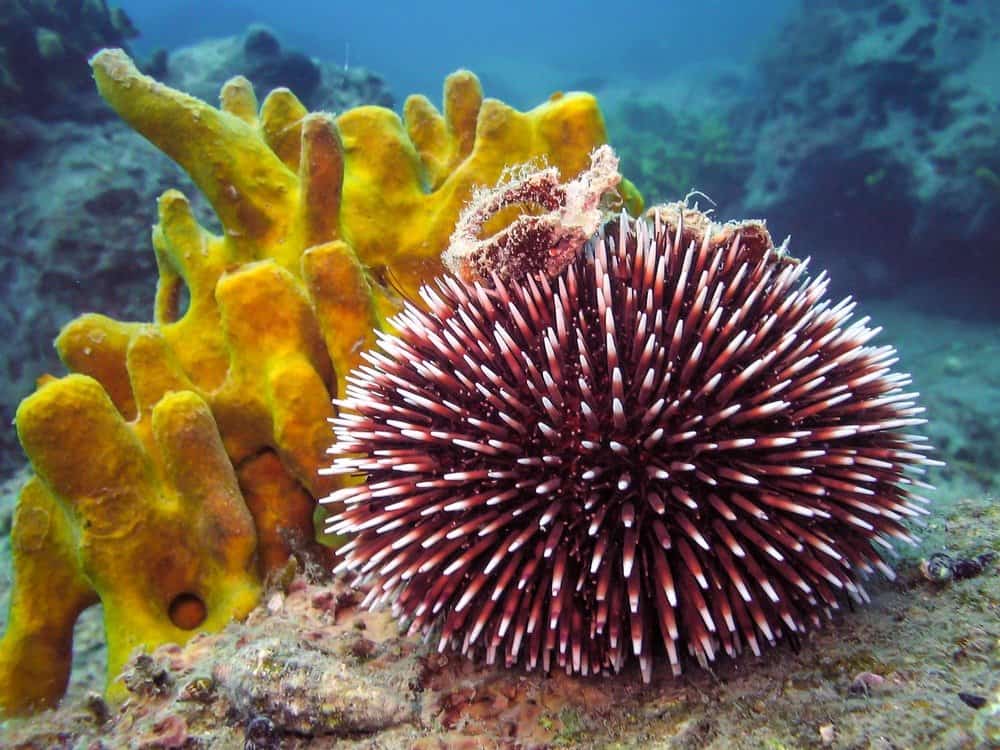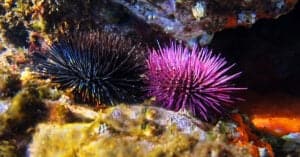Sea urchins may look timid and non-aggressive. Well, they are indeed, but did you know that sea urchins are venomous? Sea urchins have round to flattened bodies, depending on the species. Whatever the shape, all species of sea urchins are equipped with sharp spines that can break through human skin. These spines are not just sharp enough to pierce through the skin, but they also release venom that can cause severe pain and trigger infections. Are sea urchins poisonous? While they may be venomous, sea urchins are generally not poisonous or dangerous. Their stings are often not life-threatening but can be extremely painful and may cause other serious symptoms.
Do Sea Urchins Sting or Bite?

Sea urchins use their spiked shells to protect themselves from predators.
©Damsea/Shutterstock.com
Sea Urchins spines can sting humans, but the deepness of the wound depends on the pressure put onto them. Apart from their sting, sea urchins can also deliver a painful “bite” using their pincers located on the underside of their bodies, from which they also eat.
Sea urchins have two types of defense mechanisms. The first one is their long, sharp, venomous spines that spike outward throughout their bodies, and the other one is their tiny yet strong jaws or pincers known as pedicellariae that also release venom. These three claw-like pincers bite attacking predators and are also equipped with venom. Sea urchins do not usually initiate attacks and are not known to be aggressive. However, if you accidentally step on a sea urchin near rocky shallow waters, you’ll most likely get stung.
From afar, sea urchins may seem harmless and passive. It may also be difficult to spot their mouths. That is why many people assume that these marine creatures do not have mouth openings. But up close, sea urchins are covered with sharp spines containing venom. What’s even more painful about sea urchin stings is when their calcium-filled spines puncture deep into the skin and then break off. As sea urchin spines are tapered and pointy, they can easily cut through the skin, but they tend to break since their edges are brittle. Spines left underneath the skin can be hard to extract but must be removed immediately to avoid more severe injury.
Are Sea Urchins Dangerous to Humans?

Though not dangerous, sea urchins have venomous spines that are sharp enough to puncture the skin.
©narupong sooknatee/Shutterstock.com
Sea urchins do not aggressively attack humans or other animals. However, when they are accidentally stepped on, the spiky and venomous spines covering their sphere-shaped body are sharp enough to puncture the skin. They also have pincer-like jaws that deliver venom. But while sea urchins are venomous, they are not usually dangerous or fatal to humans. Their sting can cause severe pain, especially when the edge of the spine is broken and left inside the skin. Yet, sting symptoms rarely cause lasting harm. Their sting can also cause other serious symptoms, but only if the puncture wound is multiple, too deep, or not treated right away.
Sea urchins can be handled, but their spines can be very sharp, so they can pierce through the skin and release venom when not handled with care. The sea urchin’s spines instinctively release venom whenever it’s attached to an object. Stings from a sea urchin can cause mild to extreme symptoms depending on the sea urchin species and the number of puncture wounds you have endured.
The common mild symptoms of a sea urchin sting include swelling around the stung area, sensitivity or severe pain, blueness of the site, muscle aches, and redness on the puncture wound. When not treated immediately, sea urchin stings can also cause infection. However, some sea urchin species have stronger venom than others. They can leave more serious complications if not given immediate and proper medical attention.
Some people are stung more than once in a single encounter, while some may exhibit allergic reactions to the sea urchin’s venom. These cases can cause more severe symptoms such as difficulty breathing, signs of shock, fatigue, weakness, paralysis, and sometimes even death. However, most cases are usually not fatal and can be treated if attended immediately.
Are Sea Urchins Poisonous?

Sea urchins bites are not poisonous.
©JGA/Shutterstock.com
Are sea urchins poisonous? Sea urchins possess venom, but are not poisonous when they sting or bite humans. When stung by their spines or bitten by their pedicellaria, the venom will only leave puncture wounds or may trigger some allergic reactions. Yet, they cannot poison humans or other animals. Their venom is primarily used to deter predators in the ocean but is not strong enough to endanger humans.
Sea urchins are also a known seafood delicacy despite their spiny outer shells. When broken open, sea urchins sport five sets of “roe” called uni. This uni can complement dishes or be eaten on their own. However, some sea urchin species are harder to consume as they contain varying toxins that are not present in common sea urchin species. Nonetheless, sea urchins are edible, safe to be consumed, and even delicious!
How to Avoid Sea Urchin Sting
Sea urchins are not like most aggressive marine animals that purposely attack humans. Thus, the most effective way to avoid sea urchins is to keep away from the ocean floor, rocky bottoms, and sandy crevices. As they settle in rocky depths, most people accidentally step on them. The more pressure the person puts against its spines, the deeper the sea urchin’s spines will puncture the skin. Some people also try to hold sea urchins, unaware that careless handling can lead to their spines pricking into the skin. Sea urchins can also feel threatened or startled when handled, which may lead them to bite using the clawed jaws or pincers located near their mouth. Apart from keeping away from their usual habitat, it would be best if you also refrain from holding or handling sea urchins.
The photo featured at the top of this post is © narupong sooknatee/Shutterstock.com
Thank you for reading! Have some feedback for us? Contact the AZ Animals editorial team.






